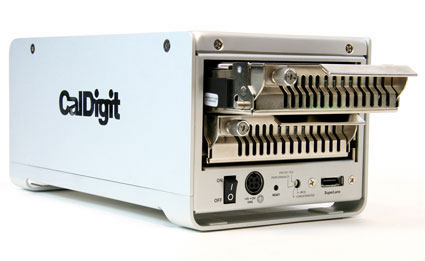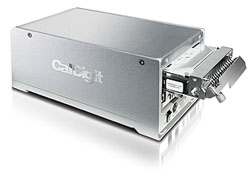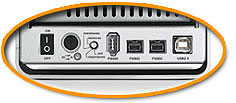| Review: CalDigit S2VR Duo Review...and Firewire VR |
May, 2007
CalDigit S2VR Duo Review...and Firewire VR

By Shane Ross
Let's start with the question on most people's minds: Who is CalDigit? Where did this company come from? Because it seemed liked they came out of nowhere last year at NAB. Well, they used to be an OEM company...meaning that they designed products for other companies to sell. In fact, they helped design quite a few G-tech products in including the G-RAID....the drive that won BEST IN SHOW at MacWorld the year it was introduced. I have two of these drives and love them. Very solid drives. That solidity continues with their current products. Anyway, the company decided it would be better business to stop making drives for other people and start selling their products themselves. So really they didn't come out of nowhere, they just came out of hiding.
For THE MEXICAN AMERICAN WAR, I used G-Raids to store all the footage. I have three drives totalling 1.2 TB, and that was plenty of space. But, I now had other projects occupying them and I needed another solution. I was about to get more G-Raids (now G-Raid 2) but heard from a Creative Cow forum leader that he was having HUGE issues with those drives when he daisy chained them. The performance would drop from 65MB/s...down to 16MB/s. a HUGE hit. Well, that left me stuck. I needed more space but couldn't go with a company that I liked. Because the G-Raid 2 was unreliable, and the G-Speed was out of my price range. I did make the Quiet Tower and set that one up and was all set to use it when CalDigit asked me to review their S2VR Duo eSATA solution.
They heard about my need for drives on the Cow, and offered me a 1.5 TB unit...containing two 750GB Seagate drives...and I leapt at the chance.
The S2VR Duo is an eSATA drive unit. The "e" stands for EXTERNAL...and being a direct external SATA connection, it is far faster than a firewire drive...even firewire 800. When I initially raided it I checked the read/write speed with the AJA Hardware Test application. On the box it claims 140MB/s...well, fully empty I got 148/MB/s read and 142MB/s write. Darn good numbers. Plenty for 6 streams of DVCPRO HD. But, as we all know, you don't get those numbers with the drive full or partially full. At 85% capacity I still got over 100MB/s. 106MB/s read and 101MB/s write. VERY respectable.
The S2VR Duo (as well as CalDigit's entire eSATA line of drive units) all employ "port multiplication" technology. That means that you only need one cable to communicate with up to five drives, instead of the one cable per drive. And since the card that ships with the drive units (that's right, it is included in the cost) has four ports, you can connect up to four drive units to one machine. Four S2VR Duo units for a total of 8 drives, or even four of their 5 drive S2VR HD units for a total of 20 drives!
The unit is capable of Raid 0, 1 and JBOD. Raid 0 is called PERFORMANCE, and basically makes both drives in the unit appear as one large one (adding together the capacity of each). So with two 250GB drives, you get 500GB at RAID 0. Raid 1 is a PROTECTED Raid....meaning that the footage is mirrored on both drives. You Raid two 250GB drives and you get 250GB of storage, and performace drops. This is ideal for backup up footage, but not for video editing. JBOD is, literally, Just a Bunch of Drives....meaning that if you have two drives that you raid JBOD, they appear as two separate drives. And then you can either use them separately, or use the drive utility to raid them.

The drives are removable, so if you working on multiple projects, you can swap out drives. It is as easy as unscrewing a screw, flipping a handle down and pulling.
Now, note that CalDigit sells complete drive solutions, meaning the unit comes populated with drives, and if you want more drives you must order from them. This is for many reasons. If you have a failure of any sort, you only have one company to call to figure it out. You don't have to call the SATA case manufacturer, drive manufacturer, cable maker and card manufacturer to try to figure things out. Often when you have multiple vendors like this, they play the "blame game" and point fingers at the other guy. With the Duo, you only have one company to call. CalDigit also is a stickler for perfection. They want to make sure you get the best performance possible, so the firmware on the drives is updated to match the controller cards. One of the reasons they get the performance they do out of the drives.
I know, I am a build it yourself guy too...note the Quiet Tower. But I also do this for a living and don't want to deal with calling a lot of vendors when things go awry. That is lost time. I also want to get drives that I know are solid and reliable. So it is worth a little extra money for me to get that piece of mind. Yes, they cost a bit more than the competition, but as I said, I find it worth it. And they aren't TOO much more expensive.
Now, one of the really handy features of this drive unit is the GUI...or graphic user interface. It ships with a drive setup utility called the S2VR Manager. This is where you configure your raid, and input some user info, such as your e-mail address. E-mail address...why that? Well, if a drive gets too hot, or shows signs of failure, then the S2VR Manager sends you an e-mail warning you of this. VERY handy. I have yet to receive this e-mail, and I hope to avoid it in the future.
When I recieved my test unit I was pleased to see how it was packaged.

The drives are separate from the unit, surrounded by padding. Very smart.
Here are a few more pics...
The empty Duo case:


The drive module:

I have a 1.5 TB unit in my edit bay and in use on my latest History Channel show. Raid 0 for speed...storing 78 hours of DVCPRO HD 720p 23.98 (with some 720p60 footage thrown in for slow motion). I am using my home built Quiet Tower as a backup unit for all the footage, just in case a drive fails or something happens (like the occasional clip vanishing in FCP....which is more common than I'd like to admit). So I have the S2VR Duo for editing, in a RAID 0 configuration, and it all backed up to another RAID 0 unit...a manual RAID 1 setup if you will. If I lost any footage, or ALL of my footage, all I'd have to do is copy the footage from one raid to the other...an overnight deal (6 hours)...instead of having to rent the DVCPRO HD deck again and spend days recapturing...and reimporting all the P2 footage and trying to relink. Having your footage backed up is a VERY wise thing. Get cheap non-video drives for this, or assemble an inexpensive drive raid. The money you invest in this will save you time and money in case you ever lose footage and need to recapture.
Anyway, back to the Duo. I have been using this drive unit since January and only had one hiccup. That hiccup being that I lost 2 files...the "vanishing clip syndrome" that I mentioned FCP does from time to time. That isn't a drive issue, but an FCP one, as I have seen people complain of this for quite some time on the forums. And I solved this hiccup by copying the clips over from my backup raid. So really no issues whatsoever. A very solid drive unit that has seen HARD work. Editing for 10-16 hour days...6 day weeks.
AND, I even took the drive on the road. I had to travel to Montana (see the blog archives) so I took the drive with me. I have a PCMCIA eSATA card so that I could still hook up the unit. Not quite the same performance that I see with the card in the tower, but it works fine, and still got me 3 streams of DVCPRO HD. I took the unit with me for two reasons. 1) I wanted to show the graduate class at MSU the steps I use while cutting, and I wanted to show them my current show as an example. 2) I just knew that I would get a call to do something with the show. I always do. And sure enough, while I was in Montana my producer called and said the network needed Act 1 on digibeta, for promotional reasons. Oh, and they needed a few changes. I was able to make the changes, export a Quicktime movie and burn it to a data DVD and FedEx it to my producer, who had it laid to tape and sent off.
So the unit worked perfectly on the road. I stored it in my suitcase, surrounded by clothes. Even with that I saw that the unit had a ding in it. The baggage handlers don't treat luggage well. I was worried that the drives wouldn't work, but they spun up fine and worked well. I did also find 3 Homeland Security notes in my bag. Guess it looks like an explosive device. For the trip home I decided not to risk it, and I bought a Pelican case for the trip home.
The S2VR Duo is a solid unit that retains drive performance, even while nearly full. This allows me to work with multiple streams of DVCPRO HD (where a firewire drive would not) and allows for more realtime effects. I recommend this unit to everyone who edits DV, HDV, DVCPRO HD, XDCAM and even uncompressed SD formats.
Now, I'd also like to touch upon the Firewire VR drive unit, also from CalDigit.


This unit is a triple interface unit, sporting Firewire 400, Firewire 800, and USB 2.0 connections. For best performance use the firewire 800 option. Empty I got 65MB/s read and 57MB/s write. Good for 3 streams of DVCPRO HD. And this unit can also be configured for Performance (RAID 0), Protection (RAID 1) and JBOD (just a bunch of drives). The difference with this unit is that the RAID is a hardware raid that is configurable...it has a switch on the back where you set these options....there is no GUI like the Duo has. You can use the unit for editing, again it is good for DV, HDV, DVCPRO HD, XDCAM, and uncompressed SD. You can work with uncompressed 8-bit fine, but uncompressed 10-bit would be pushing it.
Again, its drives are removable (hot swapable) so that you can easily replace the drives. This is good if you have multiple projects and want to save money by only getting drives, and makes this unit perfect for archiving. CalDigit pushes it as an archive solution for photographers who want to back up their photos. I myself use this unit to back up my P2 footage...Raid 1 all the way. And one cool thing about this unit is that because the RAID configurations are HARDWARE raids, not software, if a drive happens to fail, all you need to do is get a replacement drive (Caldigit offers a 3 year warranty) insert it into the slot and the Raid is automatically rebuilt...information copied over without you doing a thing. It doesn't even need to be connected to the computer.
As of the time of this posting, the Firewire VR has another advantage over all other Firewire raids. It is daisy-chainable and doesn't lose drive performance. Other firewire raid units (such as the G- Raid 2 and LaCie options) lose performance once you daisy chain them. They'll go from 55MB/s down to 16MB/s the instant you chain them....a HUGE performance drop making them unusable for DVCPRO HD. Which is a shame because I used the original G-Raids for my first show, and they are still reliable. What gives? Well, It is a combination of factors. The Oxford 924 bridge (just an aside, the Oxford group names their chip after Porche models...911, 924), the drives used in the box, the drive firmware and the onboard RAID controller. Other companies are having issues getting them to all work, but CalDigit figured out the special sauce...and have the only firewire drive raids that work without losing performance.
There you go...glowing reviews for the CalDigit S2VR Duo and the Firewire VR units. I like the units so much I use them in my bay on the shows I am editing.
Shane Ross is a freelance editor residing in Los Angeles. He edits shows for The History Channel, Discovery Channel, National Geographic and Nickelodeon.
copyright © Shane Ross 2007
This article first appeared on www.kenstone.net and is reprinted here with permission.
All screen captures and textual references are the property and trademark of their creators/owners/publishers.